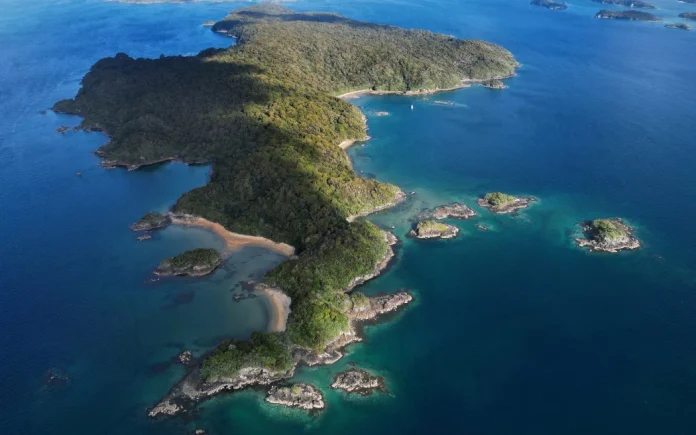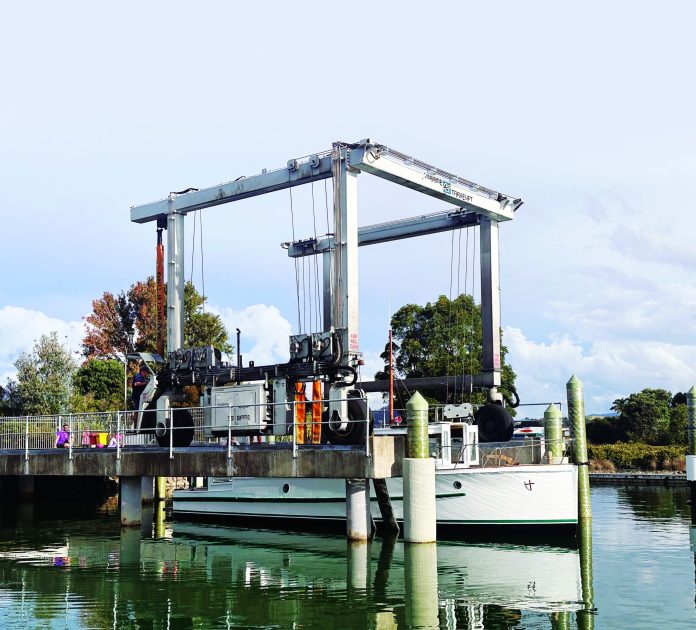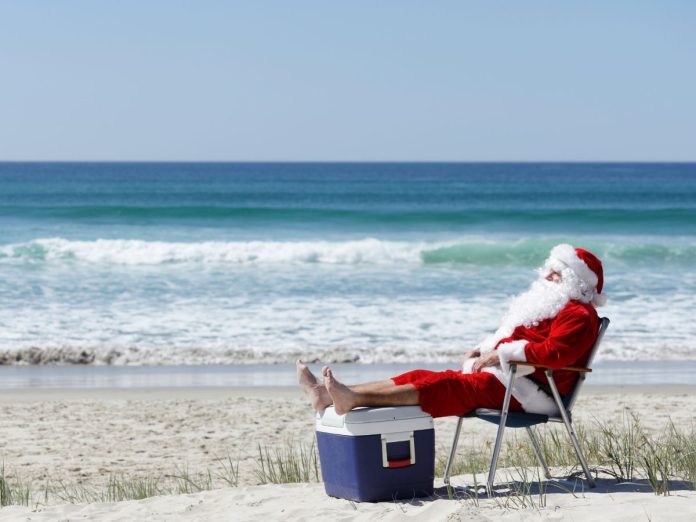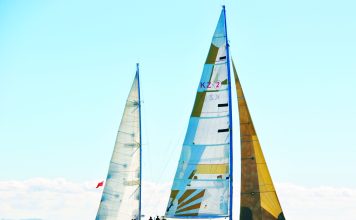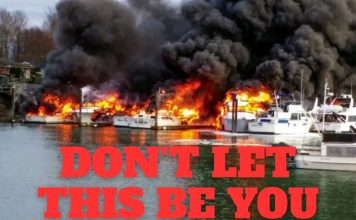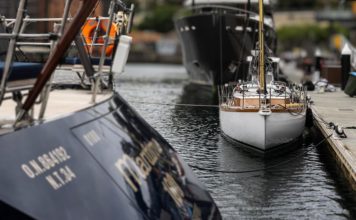[cmsmasters_row][cmsmasters_column data_width=”1/1″][cmsmasters_text]
Sometimes waves are gentle and undulating. But they can become monsters, turning a pleasant cruise into a roiling hell. This often leads to an unexpected boat sale. Matt Vance asks what’s behind their fickle action?Ocean waves are curious things.
In a cosmos full of different kinds of waves, ocean waves are one of the few that are obvious to the human eye. For the most part, they are on a scale and speed we can relate to and for that reason, if you ask a small child to draw a wave you will not get the complexity of a sound or infrared wave, but a simple blue crayon ocean wave.
While landlubbers see waves as merely a backdrop to an ocean scene, sailors know it is the one thing that more than others will determine the motion of your boat and the morale of the crew. For a boatie, the difference between a great day on the water and abject misery will be largely a function of waves.
The source of all this motion is the wind. At its essence, the wind is the earth’s way of distributing heat around. In the hot areas, the air rises and causes low pressure. In the cool areas air descends and causes high pressure.
Wind is a perpetual attempt to equalize the two systems and in doing so it keeps our climate and planet habitable. On land, the influence of wind is mostly ignored, yet when it blows over the sea it becomes the sculptor of waves and the engine of currents. Wind brings the ocean to life.

Victorian poet, Algernon Swinburne, wrote of watching “The wind’s feet shine along the sea.” While not a sailor, he was most definitely a sea-gazer of the first order. When wind moves over the surface of the sea it has an instant effect on its motion and its ability to reflect light. For the sailor reading the effect of wind on water is a fundamental literacy.
It provides understanding and a glimpse of the near future for those whose movement and safety is entirely based on the wind. To a person of the land, this may seem like sorcery and on more than one occasion I have been confronted by the statement, “But you can’t see wind!” I refer them to Swinburne but it seems the mention of obscure Victorian poets just confuses them more.

Wind blowing over open water will set up a wave train. And like an old Holden Kingswood, it will have a three-stage gearbox. The first stage is the capillary waves. These are the first corrugations you notice as a new breeze gets up. They are caused by slight speed and pressure differences as the wind blows over the surface.
Once the wave has formed the wind is able to further build the wave height by the pressure difference between the windward and leeward sides. These capillary waves are fighting the surface tension of the water and it is this tension that will make them disappear as fast as they are made if the wind ceases to blow.
This surface tension also means they look like sine waves, their troughs and crests linked together in near-perfect curves. This uniformity means capillary waves are great reflectors of light. Their darkening of the water to windward is a sure sign that a light puff of wind is on its way.
As these capillary waves strengthen they grow into the second stage of wave formation called seas. These are the one most commonly encountered in a boat and can range from a reassuring rhythm to a steep and impenetrable slop that can lead to a wet ride and turn your crew green.
Unlike the sine wave shape of the capillary wave, surface tension has less of an influence. The backs of the waves are flattened by the wind while the faces are steeper on their leeward side. Their shape is said to be trochoidal.

The development of seas is rarely uniform in direction or speed, resulting in a confusion of wave heights, directions and wavelengths. A new sea always has this confusion about it and it’s not until the wind has been blowing constantly or stopped altogether after a long time that these seas will develop into swells.
While capillary ripples will die quickly after the wind stops, seas have a longer life. As they propagate away from their area of origin, seas naturally sort themselves out into groups of common direction and wavelength. The sets of waves formed in this manner are known as swells.
The lulls are the component waves cancelling each other out while the sets are the swells being amplified by the component waves being in sync. The larger ones have a greater wavelength and can travel much faster, which is why the onset of a heavy swell sometimes precedes the storm systems that create them.
A fully-developed sea has the maximum wave size theoretically possible for a wind of a specific strength, duration and fetch. The longer, harder or greater distance over which the wind blows, the greater the potential to develop a sizeable swell.
This is why the Mediterranean with its short fetch produces short, sharp swells and the Southern Ocean with its infinite fetch consistently produces the largest swells in the world.
 If there is wind that is providing more energy than that required to create a fully-developed sea the extra energy is dissipated by the breaking of some of the seas and the creation of whitecaps. In an extreme squall, you will see this dissipation expressed as a sudden haze of spray as the tops of the waves are blown into the air.
If there is wind that is providing more energy than that required to create a fully-developed sea the extra energy is dissipated by the breaking of some of the seas and the creation of whitecaps. In an extreme squall, you will see this dissipation expressed as a sudden haze of spray as the tops of the waves are blown into the air.
Any kind of current flow will have a dramatic effect on both seas and swells. If the current is with the waves it will tend to lengthen and flatten them. If the current is against the waves it has the effect of shortening and steepening the waves. You can see this effect on any harbour in New Zealand as the tide starts to go out against the sea breeze.
When this effect is scaled up you get the likes of the Agulhas Current sweeping down around the bottom of South Africa and confronting the swell and wind of the Southern Ocean south-westerlies producing large breaking swells, which have claimed more than a few ships.
As a swell nears the shore and begins to feel the bottom (i.e. the wavelength is less than half the water depth) it will begin to slow down and stand up. This phenomenon will ensure that no matter what angle waves approach the coast it will refract to break near parallel to it. Refraction will also concentrate the wave energy on headlands and dissipate the wave energy in bays and is one of the primary shapers of our coastal landscape.
At any one time, there are several different swell patterns and directions on the open sea. The shorter they are, the closer they have formed, the longer – the more distant. This effect alone gives the sea a vitality that no lake can touch. To look at the open sea in this way is to look at the past, present and future, all in one take and in this sense render it similar to stargazing.

Whether you notice them or not, waves will set the mood of your boat. They will determine the difference between a good day and a miserable one on the water. Others of you will develop a fascination for them and spend more time than is feasible watching them.
You will begin to see beauty and pattern in equal measure and if you venture into the Southern Ocean you will see waves of a size that will briefly stop your heart with their power. You will become a wave watcher and join a small secret society dedicated to the peculiar effects of wind over water.
[/cmsmasters_text][/cmsmasters_column][/cmsmasters_row]











